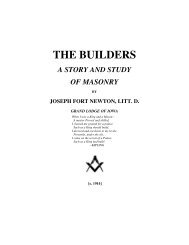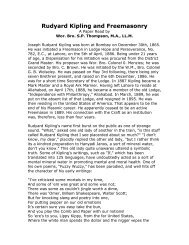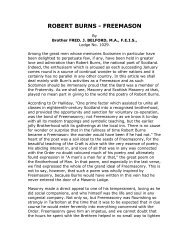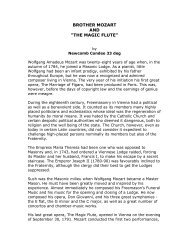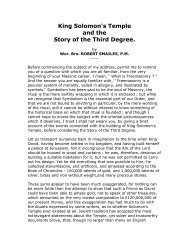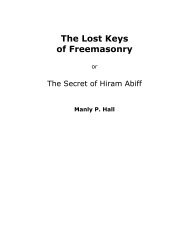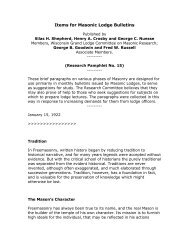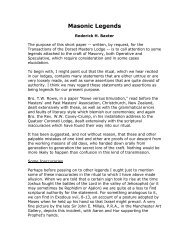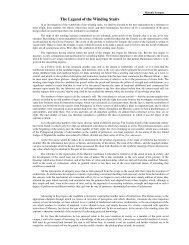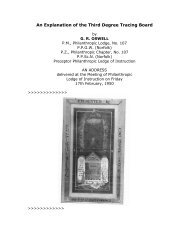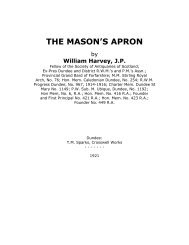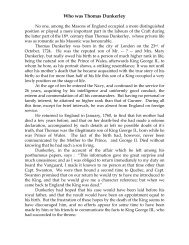Through the Key Hole - RoseCroix.org.au
Through the Key Hole - RoseCroix.org.au
Through the Key Hole - RoseCroix.org.au
You also want an ePaper? Increase the reach of your titles
YUMPU automatically turns print PDFs into web optimized ePapers that Google loves.
its Masonic symbol”.<br />
159<br />
17<br />
“ I was moved by <strong>the</strong> distinction, especially since I had been arrested by<br />
<strong>the</strong> Gestapo in Paris when I was twelve years old, however, since I was<br />
somewhat familiar with <strong>the</strong> history of German Freemasonry between<br />
both world wars, <strong>the</strong> mention of an emblem worn by German Freemasons<br />
under <strong>the</strong> Hitler regime, sounded to me a bit odd. Many German<br />
Freemasons wear nowadays a F<strong>org</strong>et-me-not pin instead of <strong>the</strong> more<br />
conspicuous square and compasses, to show <strong>the</strong>y belong to <strong>the</strong> Craft,<br />
but since when and why? I didn't know.<br />
ERNST GEPPERT’SPOINTS<br />
Tow years later I was sent a copy of a letter written by one of Germany’s<br />
foremost historians, Masonic Bro. Ernst Geppert, who was born 1916<br />
and made a Mason in 1951. In 1974 he published a tremendous [piece<br />
of scholarship—<strong>the</strong> first full list of German Lodges since 1734.<br />
when his master has no work for him. The nature of <strong>the</strong> “greeting” is<br />
unknown today but was probably a formula ra<strong>the</strong>r than a Word such<br />
as was given in Scotland.<br />
There was in <strong>the</strong> <strong>org</strong>anisation a chain of <strong>au</strong>thority not established in<br />
England, a much more compact country. The lodge was subordinate<br />
to its provincial Lodge and <strong>the</strong> chief Lodge of Strasburg was predominant<br />
over all.<br />
There is no evidence of any direct connection between <strong>the</strong> Steinmetzen<br />
and Freemasonry.<br />
His letter was addressed to <strong>the</strong> Master of a newly-founded German<br />
Lodge which had selected <strong>the</strong> blue f<strong>org</strong>et-me-not as <strong>the</strong> lodge jewel and<br />
<strong>the</strong> reason for doing so was explained in a printed note. Geppert wrote<br />
to <strong>the</strong> Master correcting <strong>the</strong> mistakes in <strong>the</strong> note and closed with <strong>the</strong><br />
remark “ You might perhaps at sometime choose to adjust your version<br />
to <strong>the</strong> factual one”.<br />
Geppert made <strong>the</strong> following points.<br />
1. The Grand Lodge used to let a pin be made for its yearly meetings<br />
and it gave one to each of <strong>the</strong> delegates. Those made for<br />
<strong>the</strong> meeting in Bremen about 1926 represented a f<strong>org</strong>et-me-not<br />
and were manufactured in a factory in Selb, a small town near<br />
Beyreuth. The brethren of Breyreuth never thought of replacing<br />
<strong>the</strong> square and compasses with a f<strong>org</strong>et-me-not.<br />
2. In 1934, <strong>the</strong> NAZI’s invented <strong>the</strong> so-called Winterhilfswerk which<br />
consisted in collecting money on <strong>the</strong> streets during specific weeks<br />
in winter. The money was in fact used for re-armament. Young<br />
sters were asked to participate and Geppert happened to be one<br />
of <strong>the</strong>se youngsters who was given about 100 badges, sometimes<br />
pins, to be sold for a minimum price. Different designs were cho<br />
sen each winter and <strong>the</strong>y were worn only during <strong>the</strong> time of a col<br />
lection to identify those who had contributed.<br />
The House of <strong>the</strong> Steinmetzen



